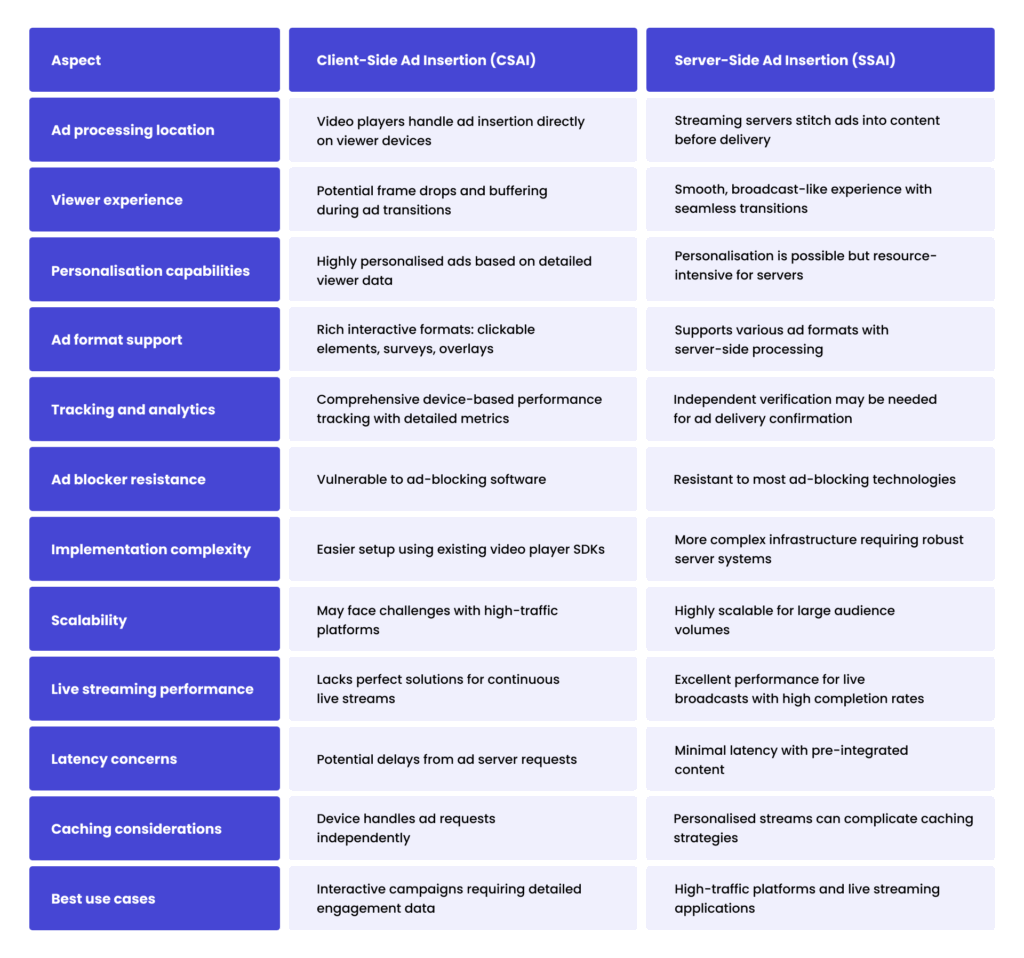Understanding OTT ad insertion: benefits and key differences explained
Ad insertion has quietly become the streaming industry’s biggest headache. In 2024, 38% of video professionals ranked it as their top challenge – more than any other streaming issue.
The reason is simple: money. Global Over-the-Top (OTT) advertising spending is projected to reach $207.52 billion by 2025, making ad implementation a crucial revenue driver. Even Netflix, which famously resisted advertising for years, launched ad-supported tiers in 2022 after recognising the massive opportunity.
Understanding the differences between Client-Side Ad Insertion (CSAI) and Server-Side Ad Insertion (SSAI) – and when to use each approach – has become essential knowledge for any streaming platform serious about OTT advertising success.
If you’re still unsure about which dynamic ad insertion approach works best for your platform, you’re in the right place. The choice isn’t always obvious, and we’ll walk you through everything you need to know to make the right decision.
What is dynamic ad insertion in OTT streaming?
Ad insertion is the automated process that places advertisements into video streams at specific moments during content playback. This technology enables streaming services to monetise their content by delivering targeted advertisements to individual viewers based on real-time data analysis.
Unlike traditional broadcast television, where commercials are permanently embedded in content, OTT ad insertion works dynamically. The system can serve different advertisements to different viewers watching the same content, personalising the video ads experience based on factors like location, viewing history, and demographic data.
The technology relies on ad markers – digital timestamps embedded within video content that signal optimal placement points for advertisements. These markers can be inserted during content preparation for video-on-demand or dynamically during live streaming events.
How does ad insertion work in practice?
Ad insertion technology operates through a coordinated process that identifies optimal moments for advertisement placement and delivers targeted content to viewers. The system begins when a video player encounters an ad marker.
At this trigger point, the platform’s dynamic ad insertion system analyses viewer data, including geographic location, device specifications, viewing history, and current TV advertising campaigns, to select the most relevant advertisement from available inventory. This selection process ensures viewers receive personalised video ads rather than generic broadcasts.
The technical implementation varies significantly depending on whether streaming platforms use Client-Side Ad Insertion or Server-Side Ad Insertion approaches, affecting everything from where processing occurs to how seamlessly advertisements integrate with content.
What is Client-Side Ad Insertion?
Client-Side Ad Insertion (CSAI) is one of the two main ad insertion methods. In this method, the viewer’s device (such as their smartphone, smart TV, or computer) takes control of the advertising process, rather than your streaming video servers handling everything.
Think of CSAI as giving each viewer’s device its own personal advertising assistant. When someone watches your content and the video player reaches the ad markers we discussed, their device springs into action: it pauses the video, contacts your ad servers directly, downloads the correct advertisement, plays it, and then resumes the original content.
This approach shifts the technical workload from your platform’s servers to millions of individual devices.
How does CSAI work?
Here’s exactly what happens when a viewer encounters an advertisement using CSAI:
- Content and ad marker detection
Video players load content files from ad delivery networks along with those ad markers we discussed earlier. - Advertisement triggering
When playback reaches these ad markers, video players temporarily halt the main content and contact the advertising infrastructure to request relevant promotional content based on the viewer data analysis we described. - Response processing
Advertising systems send back detailed instructions in industry-standard VAST format, containing everything the player needs: advertisement files, duration specifications, interaction tracking requirements, and performance measurement parameters. - Local advertisement management
Viewers’ devices take over, downloading the promotional content and managing its display within the video interface. This includes handling any viewer interactions, such as clicks or completion tracking. - Seamless transition
Once the advertising segment finishes, video players automatically return to the original content while simultaneously sending performance data back to analytics systems.
Key benefits of CSAI for streaming services
- Rich video ad possibilities: supports interactive surveys, clickable overlays, skippable ads, and engagement-driven content that generates higher revenue streams
- Comprehensive analytics: generates extensive tracking data for every viewer interaction, helping justify premium advertising rates
- Advanced personalisation: leverages detailed viewer data to deliver highly targeted advertisements that improve engagement rates
- Implementation flexibility: works with or without pre-embedded ad markers, giving platforms greater control over ad placement
Common challenges with CSAI implementation
- Playback quality issues: advertisement processing on viewer devices can cause frame drops, especially on older hardware
- Latency concerns: video players must pause content and contact ad servers, potentially disrupting smooth playback flow
- Live streaming limitations: struggles with real-time content, where seamless ad insertion becomes technically challenging
- Server dependency: relies heavily on external ad server performance, making the system vulnerable to technical disruptions
- Ad-blocker vulnerability: traditional ad-blocking software can prevent CSAI advertisements from loading, reducing fill rates and revenue potential
What is Server-Side Ad Insertion?
Server-Side Ad Insertion (SSAI) represents the second major approach to ad insertion technology, working fundamentally differently from the client-side method discussed earlier. Instead of viewer devices handling advertisement delivery, SSAI processes everything on streaming platform servers before content reaches end users.
With SSAI, advertisements get stitched directly into video streams at the server level, creating a unified content experience that resembles traditional broadcast television. Viewers receive a single, continuous video stream with advertisements seamlessly integrated, eliminating the technical handoffs between content and promotional segments.
This server-centric approach means that viewer devices never communicate directly with advertising systems, making SSAI particularly effective for reaching audiences that use ad-blocking software or devices with limited processing capabilities.
How does SSAI work?
Here’s exactly what happens when a viewer encounters an advertisement using SSAI:
- Initial viewer request
When someone starts watching content on a streaming platform, their request includes device information and viewing data that SSAI systems use for ad targeting decisions. - Real-time ad decision making
The streaming platform’s servers analyse viewer characteristics and contact advertising networks to identify the most suitable promotional content for that specific audience member. Unlike CSAI where viewer devices make these requests, SSAI handles all communication server-side. - Content assembly process
Rather than keeping advertisements separate, SSAI technology combines promotional materials with the original video content at the server level, building a custom viewing experience for each user. - Technical optimisation
Servers ensure all video elements – both original content and advertisements – maintain consistent quality standards, matching video resolution, audio levels, and playback specifications. - Single stream transmission
The completed video package is presented to viewers as one uninterrupted stream, with promotional segments seamlessly integrated into the content rather than appearing as separate downloads. This contrasts sharply with CSAI’s pause-and-resume approach. - Backend analytics collection
While viewers watch, streaming servers track advertisement performance and engagement metrics without requiring any data reporting from viewer devices.
Key benefits of Server-Side Ad Insertion for streaming services
- Seamless viewing experience: creates television-like content flow with no pauses or interruptions between promotional segments and the main content
- Enhanced reach capabilities: bypasses advertisement blocking technology since promotional content becomes part of the core video stream, making it impossible for ad-blockers to distinguish between ads and content
- Simplified device support: functions across all viewing platforms without requiring specialised software installations or ongoing technical updates
- Excellent live content performance: handles real-time streaming effectively, achieving consistently high advertisement completion rates
- Network adaptability: maintains stable playback quality regardless of the viewer’s internet connection fluctuations
- Reduced technical complexity: minimises ongoing maintenance requirements by eliminating client-side code dependencies
Common challenges with SSAI implementation
- Personalisation limitations: delivering highly customised ad experiences for individual viewers can strain server resources and reduce system efficiency
- Caching complications: creating personalised content streams makes effective caching more challenging, potentially impacting content delivery performance
- Data spoofing risks: devices can manipulate HTTP headers sent to ad servers, potentially affecting ad targeting accuracy and campaign reporting
What is the difference between CSAI and SSAI?
Now that we’ve explored both approaches individually, the natural question becomes: which one should your streaming platform actually use?
The reality is that CSAI and SSAI solve different problems for streaming businesses. CSAI excels when you need granular control over advertising experiences and detailed viewer engagement data. SSAI shines when you’re prioritising seamless playback and reaching massive target audiences without technical interruptions.
Below, we’ll compare the most critical factors:

Choose your own ad insertion strategy
With 69.9% of streaming services now using AVOD monetisation – up from just 56% last year – implementing the right ad insertion approach has become critical for streaming success.
Whether you choose Client-Side Ad Insertion (CSAI) for its detailed analytics and interactive capabilities, Server-Side Ad Insertion (SSAI) for seamless viewing and scalability, or a strategic combination of both, the key is selecting a solution that matches your content goals and audience needs.
Ready to build a streaming platform that maximises your OTT advertising revenue? At Spyrosoft, we specialise in OTT development and understand the technical complexities of both CSAI and SSAI implementations. We’ll help you create the ideal ad insertion strategy tailored to your specific platform requirements.
Explore our OTT development services and discover how we can help you succeed in the streaming services landscape.
FAQ
Client-Side Ad Insertion (CSAI) handles ad delivery on the viewer’s device, while Server-Side Ad Insertion (SSAI) processes and stitches ads into the content on the server before it reaches the viewer. In short – CSAI prioritises interactivity and data insights, while SSAI focuses on seamless playback and ad-blocker resistance.
SSAI is generally better suited for live streaming. Since it inserts ads at the server level, it avoids buffering issues and ensures a smoother experience for live viewers.
Yes. Many streaming platforms use a hybrid approach, combining SSAI for live content and CSAI for on-demand or interactive ad formats. This way, they balance scalability with engagement and precise data tracking.
Key metrics include average watch time, session duration, content completion rates, and binge-watching patterns. These indicators show not only if users are watching, but how deeply they are engaged.
It does, but with limitations. Personalising ads on the server side requires significant processing power and can impact performance. However, newer SSAI solutions increasingly use dynamic manifest manipulation and AI to improve targeting precision.
About the author
Contact us



![[thumbnail] media and entertainment - why low latency streaming matters in sports and live events](https://spyro-soft.com/wp-content/uploads/2025/08/thumbnail-media-and-entertainment-why-low-latency-streaming-matters-in-sports-and-live-events-1024x655.jpg)
![[thumbnail] media and entertainment - Subscriber acquisition vs retention](https://spyro-soft.com/wp-content/uploads/2025/09/thumbnail-media-and-entertainment-subscriber-acquisition-vs-retention-1024x655.jpg)
![[thumbnail] media and entertainment - cable vs streaming which strategy fits you best](https://spyro-soft.com/wp-content/uploads/2025/09/thumbnail-media-and-entertainment-cable-vs-streaming-which-strategy-fits-you-best-1024x655.jpg)